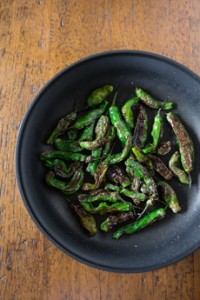TIP OF THE DAY: Shishito Chile (Or Pepper Or Chile Pepper)
 Before cooking, bright green. Photo courtesy SpoonForkBacon.com. |
The shishito pepper is a relative newcomer to American cuisine. Finger-shaped, slender and sweet (not hot), it is growing in popularity as a snack, blistered on the stove top or grill. The shishito is named after its shape: The tip of the chili pepper was seen to resemble the head of a lion (shishi) and the word for chile is togarashi. Combine the words into shishitogarashi, which is often shortened to shishito (pronounced she-SHE-toe). Bred in Japan, this East Asian variety of the New World Capsicum annuum, like many chiles, is harvested when green. It would turn red if left to ripen on the vine (that’s the difference between green and red jalapeños). While shishitos are mild, every so often a hot one will surprise you. We found one estimate that heat can occur in one out of every ten chiles, the anomaly attributed by one botanist to “stress on the vine.” Think of eating shishitos as a fun game, “Shishito Roulette.” The winners gets an extra beer! The shishito is very similar to the Spanish padrón chile, in both looks and flavor. So if you can find the latter but not the former, use the information below and cook away. |
|
|
Where to find them? We found ours at Trader Joe’s, and have also seen them at farmers markets. If you garden, you can grow your own. HOW TO SERVE SHISHITO PEPPERS If you can make roasted or charred vegetables of any kind, you can cook shishito peppers. |
||
|
WAYS TO SERVE SHISHITO PEPPERS
|
 Cooked: delightful! Photo courtesy Nutmeg Granny, who sautés her shishitos in coconut oil. Here’s her recipe. |
|
|
IS IT “CHILE” OR “PEPPER?” Chiles were “discovered” in the Caribbean by Christopher Columbus, who called them “peppers” (pimientos, in Spanish) because of their fiery similarity to the black peppercorns with which he was familiar. However, there is no relationship between the two plants (or between chiles and Szechuan pepper, for that matter). “Pepper” is wrong, but in the U.S., it seems to have taken over. Some people use “chile pepper,” a bit of a correction. The term “pepper” is not used in Latin America. There, the word is chili, from chilli, the word in the Nahuatl language of the Aztecs. But, we’d rather hear the partially incorrect “chile pepper” than the totally incorrect wrong “pepper.” Here’s more on the history of chiles. Is It Chile, Chili or Chilli? The original Nahuatl (Aztec) word is chilli. The conquering Spanish spelled it chile. In the U.K., chilli is the popular spelling. In the U.S., many people use chili, a seeming middle ground between chilli and chile. The choice is yours. We choose “chile” because it’s the spelling by which Europeans were introduced to the chilli. How many types of chiles have you had? Check them out in our Chile Glossary.
|
||


